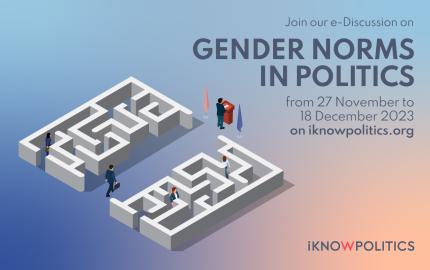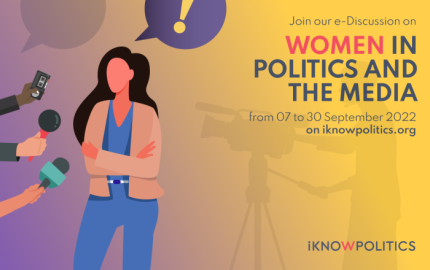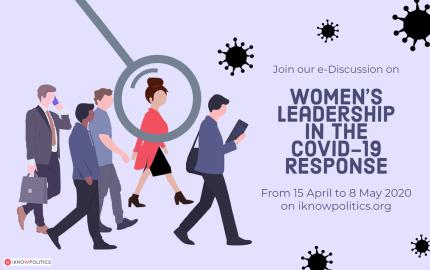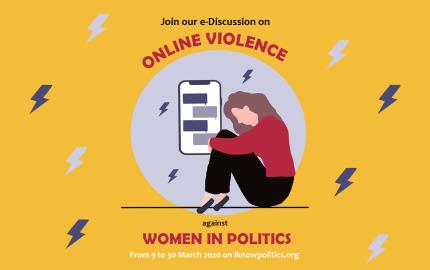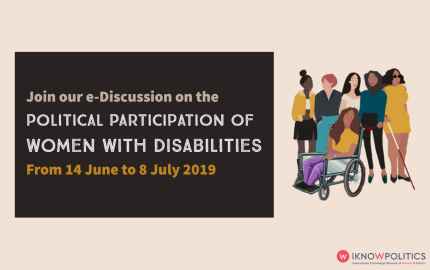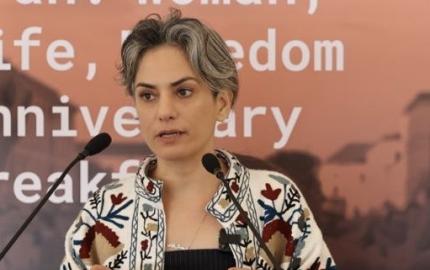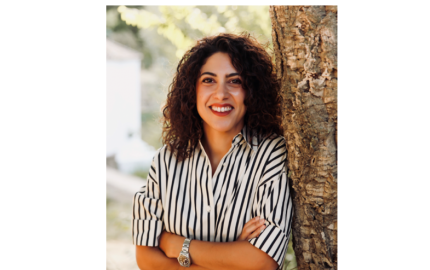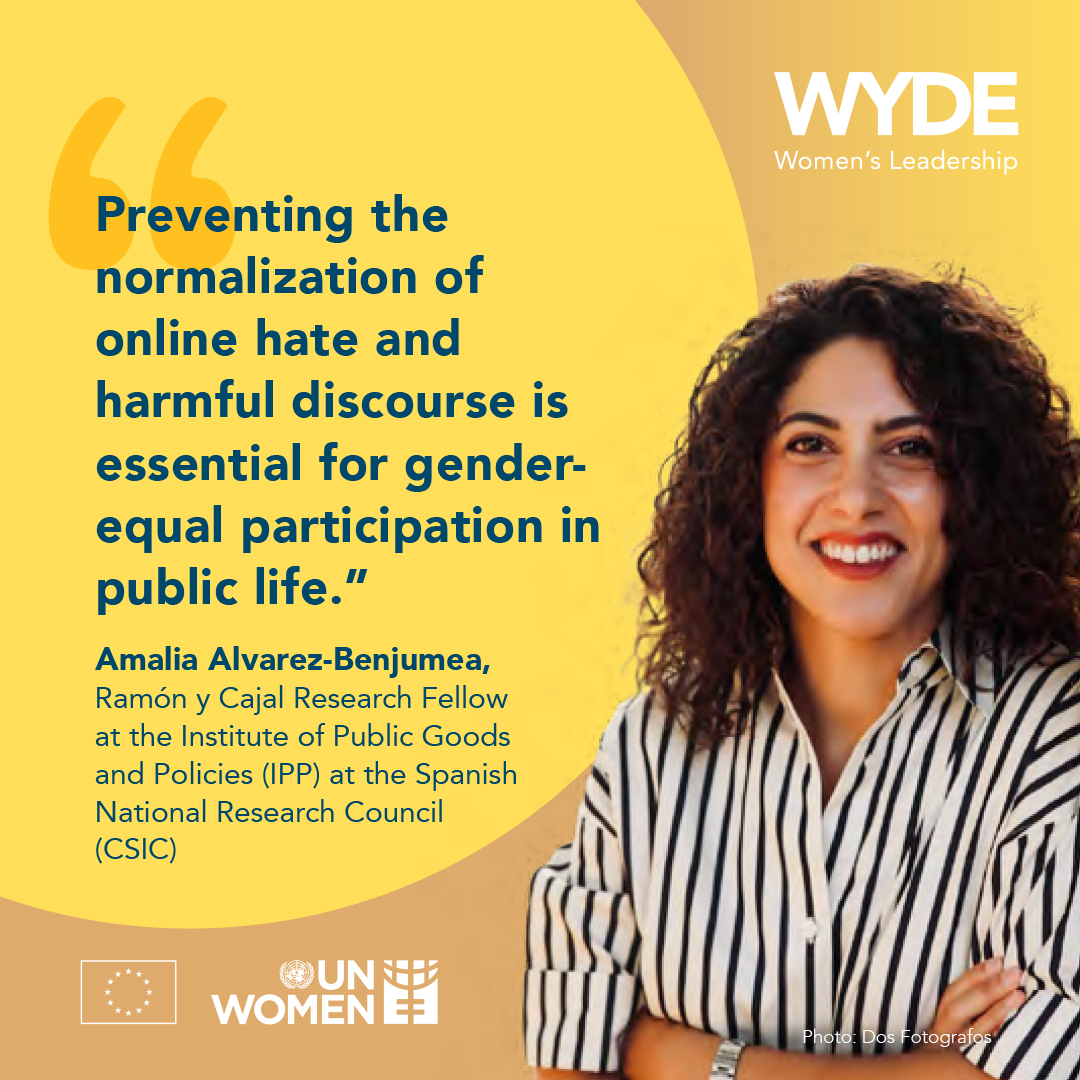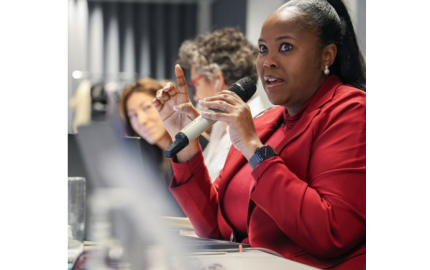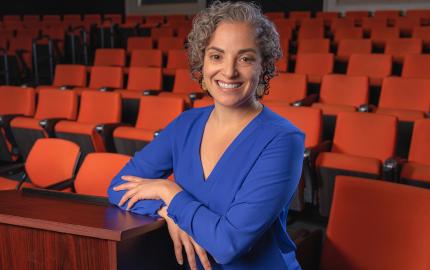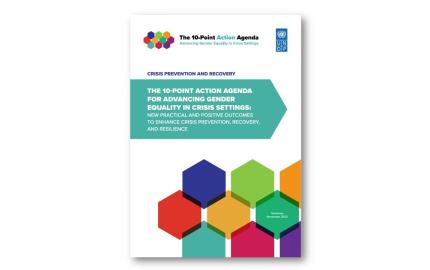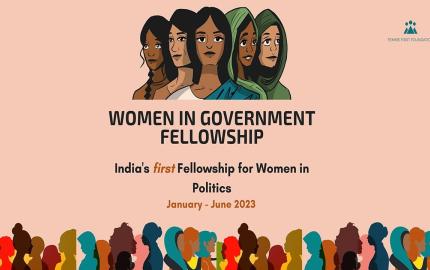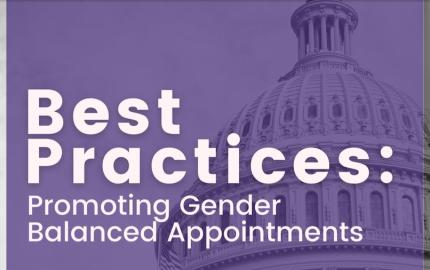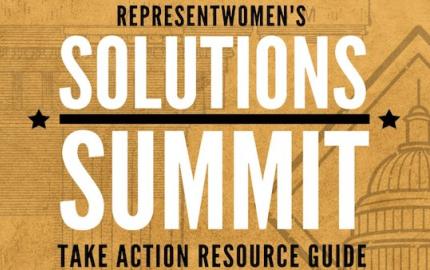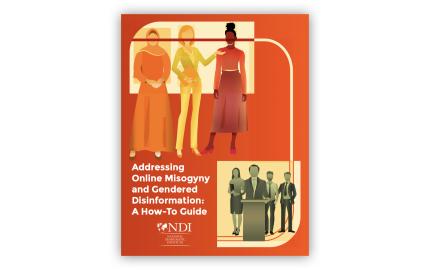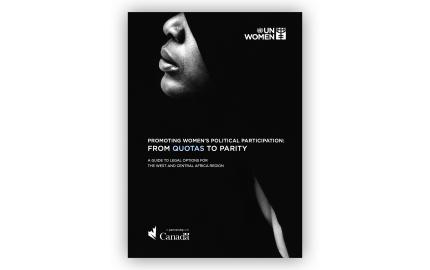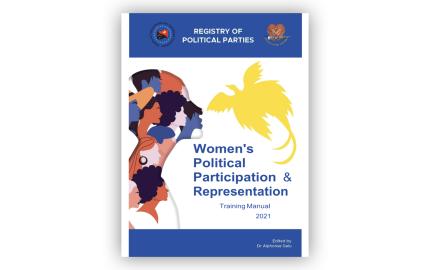Women's Leadership
Main navigation
Background
To this day, decision-making remains widely dominated by men as they make up 64% of elected local officials, 73% of parliamentarians, 77% of cabinet ministers, and about 90% of heads of government and heads of state.[1] It is estimated that at the current pace, it will take another 162 years to close the gender gap in political empowerment.
By virtue of their gender, men tend to enjoy privileges that are unavailable to women at home and work, in their communities, and in institutions. Their privileged and dominant positioning in society and decision-making places makes an impact on, for example, the way laws and policies have been designed and implemented. Male-dominated decision-making limits access to opportunities and leadership for women. Such an unequal distribution of power not only hinders women’s well-being but also humanity’s development overall. In fact, a recent study found that, on average, women are empowered to achieve just 60% of their potential.
The road to gender equality remains long and full of roadblocks, such as violence and lower access to health, education, and paid work. Women and girls continue to be subject to harmful gender norms, that are social constructs and integral to the reproduction of unequal power relations in all spheres of life, resulting in tangible consequences. For example, nine out of ten people hold biases against women and half of them believe that men are better political leaders than women.
The rise of global crises, from wars to pandemics and climate change, impact women’s lives disproportionally, burdening them further, and stalling progress towards gender equality even more. Humanity is at a critical crossroads. To build a peaceful, democratic, and sustainable future, it has no choice but to change social norms to empower women and girls in all their diversity and reach equality for all.
Objective
This e-Discussion seeks to raise awareness and collect experiences and knowledge on gender norms change and their impact on women’s political empowerment, participation, and leadership in politics and public life. It also seeks to gather good practices and recommendations on ways to shift gender norms to end the cycle of discrimination and achieve gender equality in politics and public life.
Women and men in politics, civil society activists, practitioners and researchers are invited to join this e-Discussion from 27 November to 18 December 2023 by answering the below questions. The submissions will contribute to a report that will augment the knowledge base available on the topic.
Questions
- In your opinion and based on your experience, how can gender norms change? How can their change impact women’s participation and leadership in politics and public life? Please share examples.
- What can lawmakers, governments, and civil society do to contribute to gender norms change? Please share examples.
- In your opinion, how have gender quotas impacted gender norms change and perceptions of women leaders?
To contribute
- Use the comments section below; or
- Send your contribution to connect@iknowpolitics.org so that we can post below on your behalf.
_________________________________________________________________________________
[1] Data valid as of 1 November 2023, calculations by UN Women.
Background
“The press was as kind as it knew how to be. It meant well and did all for us it knew how to do. We couldn't ask it to do more than it knew how.” [Laughter] — Susan B. Anthony, 1893
Susan B. Anthony was familiar with the press’ ways. Journalists relentlessly ridiculed the women’s suffrage movement.[1] Fast forward to more than a century later, women in public life still face biased, sexist, and discriminatory media treatment. Research over the past few decades reveals that women in politics continue to be at a disadvantage when it comes to media coverage.
When reporters cover women in politics, they often use terms that emphasize women's traditional roles and focus on their appearance. They perpetuate stereotypes of women politicians as weak, indecisive, and emotional. They sometimes even hold women politicians accountable for their children’s or husbands’ actions, though they rarely hold men politicians to the same standards.[2]
A study by the Inter-parliamentary Union on violence against women parliamentarians reports that the media can perpetuate rumors and misogynistic behavior. The study’s survey revealed that 27.3% of the participating women MPs said that traditional media had shared highly contemptuous or sexually charged images or comments about them. The percentage rose to 41.8% when they were asked about photos or comments disseminated through social media.
Globally, women in politics, particularly women of color, experience overwhelming levels of abuse and gendered disinformation campaigns, which traditional and social media often fuel and perpetuate. With the purpose of discrediting, delegitimizing, and silencing women in politics, studies have shown that women are often discouraged and dissuaded from getting involved in politics because of gendered media reporting.
Indeed, sexist media coverage contributes to the under-representation of women in politics.[3] A worldwide study found that while women’s position has generally progressed, it is slower in media representation and politics. Further, it concluded that the more there is sexism in the media, the less women candidates there are.[4] The media has a powerful influence on voters and gender differences in media coverage can have real electoral consequences. Not only can it dissuade women from engaging in politics, but it also discourages political parties and political elites from selecting women as candidates.[5]
Objective
This e-Discussion seeks to raise awareness and collect experiences and knowledge on gender differences in political media coverage, its impact on women’s political participation and representation, as well as gather good practices and recommendations on ways to counter the negative impact of media portrayals of women in politics with fair and unbiased coverage.
Journalists, producers and editors, media monitoring institutions, electoral management bodies, women and men in politics, political party leaders and members, civil society and women’s rights activists, practitioners, and researchers are invited to join this e-Discussion from 07 to 30 September 2022 by answering the below questions. The submissions will contribute to a report that will augment the knowledge base available on the topic.
Questions
- Are women politicians less visible or covered differently than men in political news coverage in your country? Please share data, if available.
- What can lawmakers, governments, and civil society do to ensure media outlets/journalists deliver fair and balanced media coverage of women and men in public life?
- With sexist traditional media coverage disseminated on social media, women in politics are exposed to vicious online attacks and abuse by often anonymous perpetrators. What can social media companies, media outlets, governments, lawmakers, and other decision-makers do to put an end to the crisis of online violence against women in politics?
To contribute
- Use the comments section below; or
- Send your contribution to connect@iknowpolitics.org so that we can post below on your behalf.
________________________
Notes:
[1] Maria Braden, Women Politicians and the Media. (University Press of Kentucky, 1996), 1.
[2] Ibid.
[3] Loes Aaldering and Daphne Joanna Van Der Pas, Political leadership in the media: Gender bias in leader stereotypes during campaign and routine times. British Journal of Political Science 50: 911–31. 2018.
[4] Amanda Haraldsson and Lena Wängnerud, The effect of media sexism on women’s political ambition: Evidence from a worldwide study. Feminist Media Studies 19: 525–41. 2019.
[5] Daphne Joanna Van der Pas and Loes Aaldering, “Gender Differences in Political Media Coverage: A Meta-Analysis” Journal of Communication, Volume 70, Issue 1 (February 2020): 114-143. doi.org/10.1093/joc/jqz046
.
Background
Women’s right to equal opportunities and participation in public life is guaranteed by international agreements such as the Convention on the Elimination of All Forms of Discrimination against Women, the Beijing Platform for Action, and the Sustainable Development Goals. Women are active in both the formal and informal public spaces, including in social and political movements as civil society activists, political candidates and leaders, and peace negotiators.
Over time, women activists and feminist movements have led efforts globally and nationally to advance the gender equality and women’s empowerment agenda in all spheres of life. For instance, in politics they were instrumental in achieving women’s suffrage, as well as the introduction of gender-sensitive laws and electoral gender quotas in many countries. Albeit still far from parity, women’s participation and representation in formal political institutions has increased in recent decades as a result of those reforms. For instance, women’s representation in national parliaments has nearly doubled in the last twenty years, rising from 13.4%in 2000 to 24.9%in 2020.
With the rise and renewed uses of the internet, women are using both formal and informal spaces to drive change for a more democratic and sustainable world free from discrimination. Social media tools enable digital activism and grassroots movements with unprecedented speed, reach, and often impact, transforming institutional and traditional activism and civic spaces.
Objective
This e-Discussion aims to explore and raise awareness on the different ways and forms women participate in public life outside of formal political institutions, such as in women’s and feminist movements, civic demonstrations and initiatives and online activism. Activists in civic and political movements, civil society groups, political parties, social media campaigns, as well as practitioners and researchers on issues related to political and public engagement are invited to join this e-Discussion from 24 August to 14 September 2020. Submissions will contribute to the elaboration of a Consolidated Reply that will augment the knowledge base available on the topic.
Questions
- How have women outside of formal roles advanced the gender equality agenda and influenced other public debates and decisions? Please share concrete examples.
- In organizing and pushing for change, many women activists develop valuable leadership skills. Can you share examples of women in politics who entered the formal political sphere after engaging in informal spaces?
- What is the role of youth, including young women, in driving public and civil society movements and influencing decision-making? Is the public engagement of today’s youth different from previous generations’?
To contribute
- Use the below comment section below.
- Send your contribution to connect@iknowpolitics.org so that we can post it on your behalf.
Background
Women are hardest hit by the current COVID-19 pandemic and its impacts. Beyond the direct effect of the infection by the coronavirus, women’s health and safety are at greater risk as increased prevalence of domestic violence and abuse is reported and sexual and reproductive health services are reduced. In this time of unprecedented crisis, women also face an increased burden of care and subsequent risk of getting sick because they represent the majority of front-line healthcare workers and caregivers in homes and communities globally. This is all in addition to the disproportionate indirect impact of the pandemic on women’s livelihoods everywhere. With the majority of women working in the informal economy, they often lack health insurance and social security, putting them further at risk.
While women make up 70% of the world’s healthcare workers and are overall more vulnerable in times of crisis, they only make up 25% of legislators and 6% of state and government leaders. Emergency response taskforces around the worlds are overwhelmingly male-dominated, as seen for example in the United States and the United Kingdom. Additionally, few women are invited and quoted in the media to provide expertise on relief and recovery responses.
Representation always matters, especially in times of crisis. The ways we respond to the pandemic and its ramifications will challenge democratic institutions in an unprecedented way if the appropriate steps are not taken. With elections being postponed or remote voting anticipated, parliaments closing or deliberations taking place online, and traditional media spaces reduced, women’s voices may be further silenced as gender equality issues move to the back burner.
To ensure an optimal relief and recovery response without compromising women’s safety and rights, governments and decision-makers across all sectors must include a gender perspective in all decisions. Gender-sensitive policies that recognize and respond to women’s needs will benefit not just women but society at large. More than ever, this crisis has shown that people’s safety and wellbeing is determined by decision makers, both elected and unelected. We are all as vulnerable as the most vulnerable among us.
Objective
With nearly two million cases and over one hundred thousand deaths deplored, the stakes are too high to ignore women’s voices and the perspectives and resources they bring to the table. This e-Discussion raises awareness about the lack of women’s leadership and representation in relief and recovery decision-making and on the importance of incorporating gender-sensitive responses during and after the crisis. Women and men in politics, civil society activists, practitioners and researchers are invited to join this e-Discussion from 15 April to 8 May 2020. The submissions will contribute to the elaboration of a Consolidated Reply that will augment the knowledge base available on the topic.
Questions
- Is sex-disaggregated data on the effects of the pandemic available? How has your national and local government responded to the specific needs of women and girls in your area?
- Are women leaders visible in your country/area? Can you share examples of successful women leaders’ initiatives to mitigate coronavirus impacts? What sector are they working in, and what contributions did they make?
- What can be done by governments, parliaments, civil society, and the media to ensure women’s voices are more included?
- What are the non-formal sectors and spaces where key decisions are being taken and women’s voices need to be bolstered (e.g. logistics, supply chains, etc.)?
To contribute
- Use the below comment section below.
- Send your contribution to connect@iknowpolitics.org so that we can post it on your behalf.

The United Kingdom’s Health Secretary is one of many political figures that recently expressed their dismay at the number of women Members of Parliament (MPs) who renounced standing for re-election to Parliament and decided to leave politics after citing rising online harassment and abuse. Recent reports show similar trends in many other countries, such as the United States, India, Kenya, and Colombia.
Politics is a hostile environment to women everywhere. An Inter-parliamentary Union (IPU) global study published in 2016 and a 2018 study focused on European countries found that violence against women MPs is very widespread, with varying prevalence in different regions and countries of the world. According to IPU’s research, psychological violence -- which includes sexist and misogynistic remarks, humiliating images, intimidation and threats of death, rape, beatings or abduction -- is the most common form of violence women MPs face, affecting more than 80% of the global survey respondents. It also suggests that digital communication is the main tool used to deliver threats of death, rape and beatings against female MPs and that most perpetrators are anonymous users. Moreover, IPU reports that 58% of the European study respondents and 42% of those in the global study received online sexist attacks on social media, notably Facebook, Twitter, and Instagram.
Online violence is a phenomenon of pandemic proportion as reports suggest that almost three quarters of women Internet users worldwide have experienced some form of online violence.[1] Online presence, mainly through social media, can be described as a double-edged sword for women politicians: [2] while it is a unique and extremely useful tool to directly communicate with constituencies and to mobilize support and engagement, it provides a forum where violence can proliferate with impunity.
A forthcoming research study[3] based on social media trends analysis in seven countries (Zimbabwe, Haiti, Afghanistan, Nepal, Papua New Guinea, Sri Lanka, and Ukraine) reveals growing online incivility, hate speech, and overt violence against women in politics. It reports little regulation and widespread impunity and concludes there is a real negative effect on women’s freedom of expression and political participation. Online and offline violence against women in politics is a violation of human rights and, by hindering women’s political participation, is also a violation of women’s political rights. As such it undermines democratic exercise and good governance, and creates a democratic deficit.[4]
Objective
This e-Discussion seeks to raise awareness on the online harassment, abuse, and violence against women in politics by encouraging a dialogue and an exchange of knowledge, experiences, and solutions to fight this phenomenon and ensure online and political spaces are safe and inclusive. Women and men in politics, civil society activists, practitioners and researchers are invited to join this e-Discussion from 9 to 30 March 2020. The submissions will contribute to the elaboration of a Consolidated Reply that will augment the knowledge base available on the topic.
Questions
- Why do you think online harassment and abuse of women in politics occurs and is so widespread?
- What can States do to stop online harassment and violence against women while respecting freedom of expression and the prohibition of incitation to violence and hatred? What are the good practices?
- What can social media outlets such as Facebook, Twitter, and Instagram do to make their spaces safe for women?
- Online violence against women in politics makes political careers unattractive. What message would you give to women who are considering leaving politics or discouraged from engaging in public life because of this?
To contribute
- Use the below comment section below.
- Send your contribution to connect@iknowpolitics.org so that we can post it on your behalf.
[1] Cyber Violence against Women and Girls - A report by the UN Broadband Commission for Digital Development Working Group on broadband and Gender, Page 2. 2015: en.unesco.org/sites/default/files/genderreport2015final.pdf
[2] #SHEPERSISTED: Women, Politics & Power in the New media World, Page 23. 2019: she-persisted.org/
[3] Defending Democracy in Digital Spaces: Ending Violence Against Women in Politics Online. IFES, forthcoming.
[4] United Nations, “Report of the Special Rapporteur on violence against women, its causes and consequences on violence against women in politics”, para 11. August 2018. See also UN Women, “Violence against women in politics: Expert Group Meeting report and recommendations”, 2018, and NDI, Not The Cost: Stopping Violence Against Women in Politics, 2016.
Background
It is estimated that 15% of the world’s population live with some form of disability and that prevalence is higher among women, as about 1 in 5 women 18 years and older live with one. The 12th session of the Conference of States Parties to the Convention on the Rights of Persons with Disabilities (CRPD) took place in the UN Headquarters in New York from 11 to 13 June 2019 and focused on the overarching theme of "Ensuring the inclusion of persons with disabilities in a changing world through the implementation of the CRPD." The CRPD, which includes gender equality as one of its general principles, recognizes “that disability is an evolving concept and that disability results from the interaction between persons with impairments and attitudinal and environmental barriers that hinders their full and effective participation in society on an equal basis with others.” [1][2]
In 2019, women still represent a small minority of elected representatives and political decision-makers everywhere. Worldwide, only 24.3% of parliamentarians, 6.6% of heads of state, and 5.2% of heads of government are women.[3] Data on political participation of women with disabilities is scarce. According to the UN Flagship Report on Disability and Development, the limited available data shows an “extremely low” participation and representation of women with disabilities in political leadership roles. It reports that “[T]he representation of women from organizations of persons with disabilities tends also to be low in national coordination mechanisms on disability matters” and that their representation “in national machinery for gender equality is even lower.”[4]
Everyone has the right to take part in government [5] and public affairs, to vote, and to be elected. [6] Women with disabilities are a diverse group who experience various degrees of discrimination and face many systemic barriers to the exercise of their political rights and empowerment because of their gender and disability. These barriers can be of legal, physical, and attitudinal nature, and include an inadequate access to education, health care, employment, and justice.
Objective
This e-Discussion aims to promote a dialogue on the political participation of women with disabilities, in all their diversity, and exchange knowledge and good practices on ways to increase and strengthen their representation in political institutions and national and local elected bodies. Please join the e-Discussion from 14 June to 8 July 2019. Civil society advocates including representatives of organizations of persons with disabilities, women and men in national and local politics, government representatives, experts, practitioners, and academia are invited to contribute with their experiences by answering to one or more of the below questions. The submissions will contribute to the elaboration of a Consolidated Reply that will augment the knowledge base available on the topic. .
Questions
- What is the level of political participation of women with disabilities in your country/region? Where can this information be found?
- Amongst women with disabilities in political leadership roles in your country, which groups of women with disabilities (e.g. women with sensory disabilities such as visual and hearing impairments, physical disabilities, and intellectual and psycho-social disabilities) are most represented?
- What are the obstacles limiting women with disabilities’ participation and representation in politics in your country?
- What can be done to increase women with disabilities’ access to political leadership roles in your country? How inclusive of women with disabilities are existing programmes focused on women’s political participation? Please share concrete examples of programmes, laws, regulations, and practices.
To contribute
- Use the below comment section below.
- Send your contribution to connect@iknowpolitics.org so that we can post it on your behalf.
_____________________________________________________
[1] Convention on the Rights of Persons with Disabilities, Preamble, para (e). 2006.
[2] See also Articles 6 and 29 of the CRPD.
[3] Map of Women in Politics. UN Women and IPU, 2019: unwomen.org/en/digital-library/publications/2019/03/women-in-politics-2019-map
[4] Realization of the Sustainable Development Goals by, for and with Person with Disabilities, UN Flagship Report on Disability and Development 2018, page 110.
[5] Universal Declaration of Human Rights, Article 21. 1948: ohchr.org/EN/UDHR/Documents/UDHR_Translations/eng.pdf
[6] International Covenant on Civil and Political Rights, Article 25. 1966: ohchr.org/EN/ProfessionalInterest/Pages/CCPR.aspx
